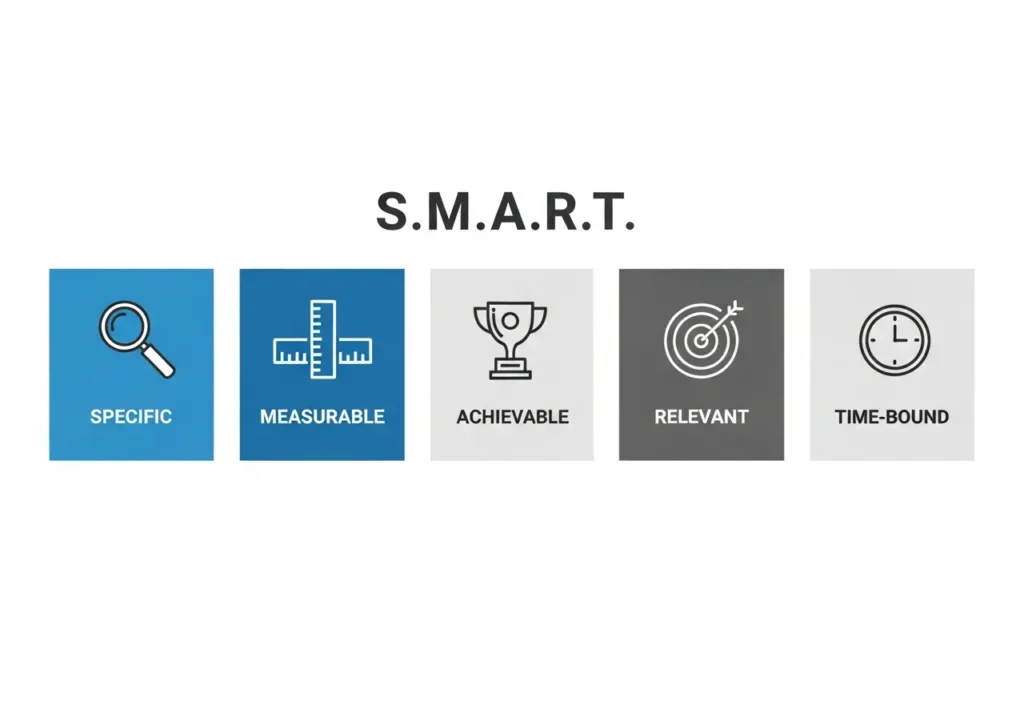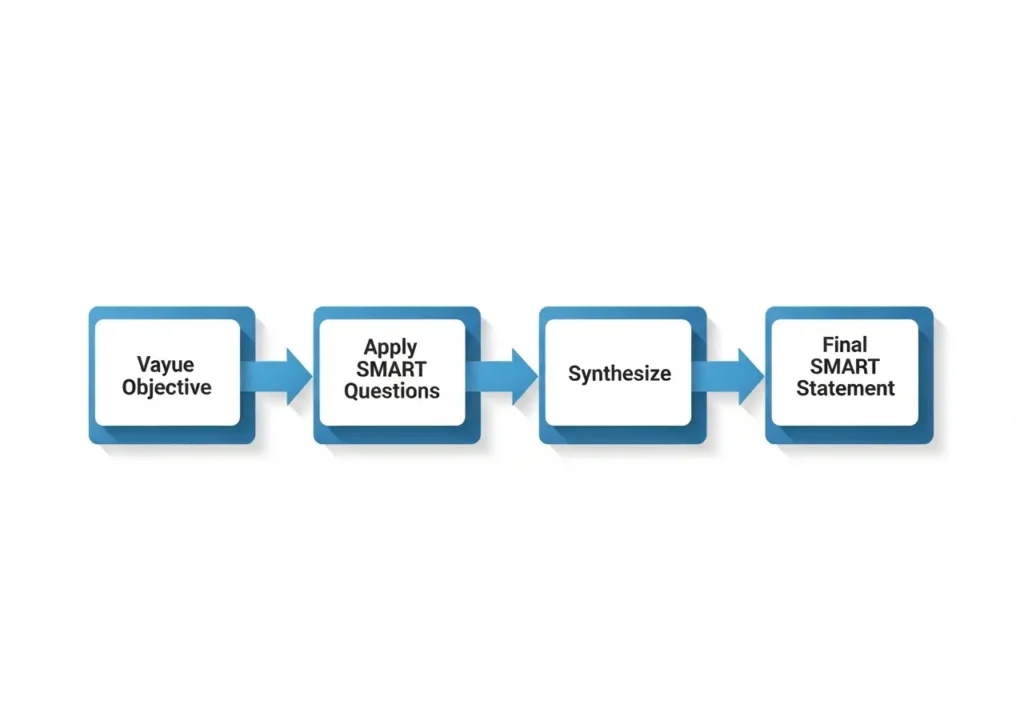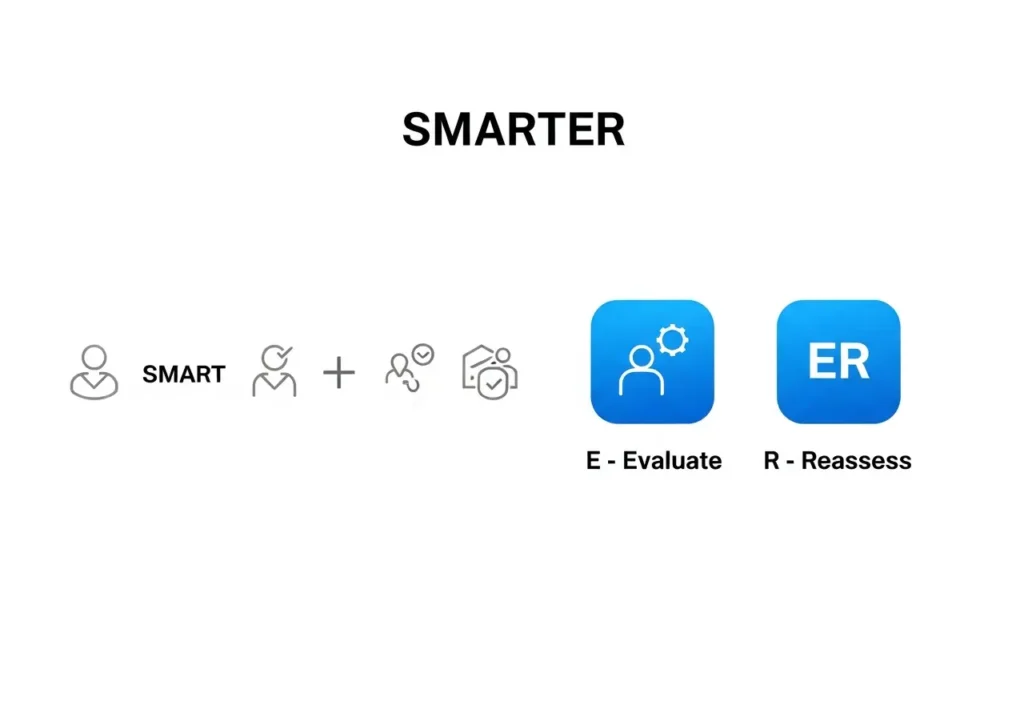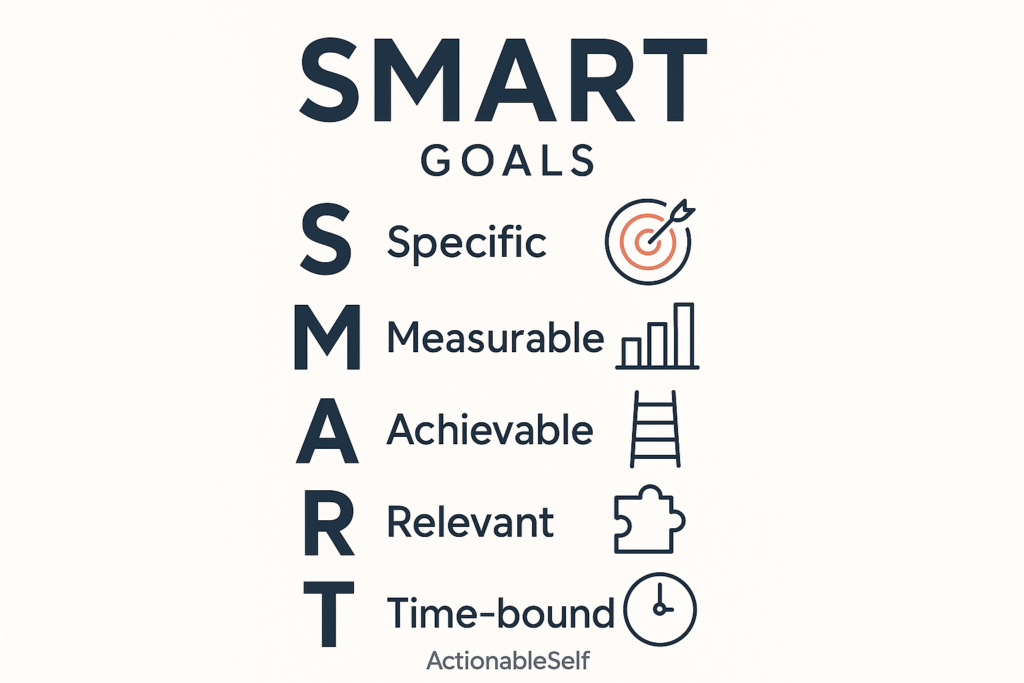A goal without a clear plan is just a wish. We’ve all been there: setting vague resolutions only to see them fade by February.
Ambitious achievers don’t rely on wishes; they rely on systems. The SMART goal framework is that system—a simple, powerful tool for bringing clarity and focus to your objectives.
This is more than just a list. This is an operational manual. You’ll get detailed examples, copy-paste templates, and the advanced SMARTER framework to turn your ambitions into achievements. For a complete overview of goal-setting theory, see our Pillar Guide to Goal Setting.
What Are SMART Goals? The Framework Explained
SMART is an acronym that provides a structured checklist for creating effective goals. It ensures your objectives are clear, measurable, and grounded in reality.
The 5 Components of the SMART Acronym (A Quick Breakdown)
- Specific: Clearly define what you want to accomplish.
- Measurable: Include metrics to track progress and mark success.
- Achievable: Ensure the goal is realistic and attainable.
- Relevant: The goal must align with your broader objectives and values.
- Time-bound: Set a clear deadline to create urgency and focus.

Why This 1981 Framework Still Dominates Modern Goal Setting
Originally introduced by George T. Doran in 1981, the SMART framework endures because it works. It forces you to move from abstract ideas to a concrete plan of action, dramatically increasing your chances of success. For a deep dive, read our guide on what SMART goals are.
How to Write a SMART Goal in 4 Steps (+ Copy-Paste Template)
Here is the system to transform any vague idea into a powerful objective.

Step 1: Start with a Vague Objective
This is your raw idea. Example: “I want to be a better public speaker.”
Step 2: Apply the 5 SMART Questions
- Specific: What exactly will I do? (e.g., “Deliver a presentation without using filler words.”)
- Measurable: How will I measure success? (e.g., “Get feedback scores of 4/5 or higher.”)
- Achievable: Is this realistic for me right now? (e.g., “Yes, I have a conference in 3 months.”)
- Relevant: Why is this important? (e.g., “It will increase my visibility for a promotion.”)
- Time-bound: When will I achieve this? (e.g., “By the end of Q3.”)
Step 3: Synthesize into a Clear Statement
Combine your answers into a single, powerful goal statement.
Your Copy-Paste Template:
Create a Perfect SMART Goal in Under 3 Minutes
Our free, interactive SMART Goal Generator asks the right questions and builds a professional goal statement for you.
Try the Free Goal Generator Now →The Ultimate Hub: 30+ SMART Goal Examples for Every Area of Life
Use these examples as a starting point. The real power comes from adapting them to your unique situation.
SMART Goal Examples for Career & Professional Development
For Leadership & Management
| Vague Goal | SMART Goal |
| Improve team morale. | To increase team morale and psychological safety, I will implement a weekly anonymous feedback system and conduct one-on-one check-ins with each of my 5 direct reports every two weeks. I will measure success by aiming for a 15% improvement in our quarterly team engagement survey score by the end of Q4. |
| Be a better manager. | I will complete a certified leadership training course (at least 20 hours) and read three recommended books on management by June 30th. I will apply these learnings by creating and sharing a personal leadership philosophy document with my team and soliciting their feedback. |
For Sales & Marketing
| Vague Goal | SMART Goal |
| Increase sales. | I will increase my qualified sales leads by 20% (from 25 to 30 per month) by the end of this quarter. I will achieve this by increasing my cold outreach on LinkedIn by 30% and by refining my email pitch, aiming to improve the open rate from 15% to 25%. |
| Get better at social media. | To increase brand engagement, I will grow our company’s Instagram follower count by 15% (from 10k to 11.5k) over the next 90 days. I will do this by posting 5 high-quality stories per week, running one targeted ad campaign, and collaborating with two industry influencers. |
Niche Focus: SMART Goal Examples for Healthcare & Education
For Nursing & Therapy Professionals
| Vague Goal | SMART Goal |
| Be a better nurse. | To improve patient safety and efficiency, I will reduce my medication administration error rate to zero and complete all patient charting within 30 minutes of patient discharge for the next 60 days. I will track this daily via self-audit and seek feedback from my charge nurse. |
| Get a new certification. | I will obtain my Critical Care Registered Nurse (CCRN) certification within the next 6 months. I will achieve this by studying for 5 hours per week using the AACN’s recommended materials and successfully passing the certification exam on or before May 1st. |
For Teachers & Educators
| Vague Goal | SMART Goal |
| Help my students more. | To improve student outcomes in my 10th-grade algebra class, I will increase the average student score on the end-of-semester final exam by 10% compared to last semester. I will achieve this by implementing bi-weekly review quizzes and offering one hour of after-school tutoring twice a week. |
| Improve parent communication. | I will increase parent engagement by sending a bi-weekly classroom newsletter and ensuring a 100% response rate to all parent emails within 24 hours for the entire fall semester. Success will be measured by a 20% increase in parent attendance at parent-teacher conferences. |
SMART Goal Examples for Personal Growth
For Health & Fitness
| Vague Goal | SMART Goal |
| Get in shape. | I will successfully run a 5k race in under 30 minutes by September 15th. I will achieve this by following a 12-week beginner’s running plan, which includes running 3 times per week, and incorporating 2 days of strength training to prevent injury. |
For Personal Finance
| Vague Goal | SMART Goal |
| Save more money. | I will save $6,000 for a down payment on a house over the next 12 months. I will achieve this by automatically transferring $500 from my checking to a high-yield savings account on the 1st of every month and by reducing my spending on dining out by 30% (approx. $150/month). |
The Next Level: Why Ambitious Achievers Use SMARTER Goals
At ActionableSelf, we believe setting the goal is just the starting line. The real advantage comes from building a system for achievement. That’s why we advocate for the SMARTER framework.
The SMART framework is excellent for setting a goal. The SMARTER framework is a system for achieving it.

What is the SMARTER Framework? (Adding Evaluate & Reassess)
- Evaluate: Consistently check in on your progress. This is about creating a feedback loop.
- Reassess (or Reward): Adjust your approach based on your evaluation. If you’re on track, reward yourself to maintain motivation. If you’re off track, re-strategize.
A Practical Example: Transforming a SMART Goal into a SMARTER System
- SMART Goal: “I will increase my qualified sales leads by 20% by the end of this quarter.”
- SMARTER System: “I will increase my qualified sales leads by 20% by the end of this quarter. (E) I will evaluate my progress every Friday by tracking my outreach numbers and open rates in a spreadsheet. (R) If I am behind schedule by more than 10% for two consecutive weeks, I will reassess my email pitch with a senior colleague. If I hit my monthly sub-goal, I will reward myself with a nice dinner out.”
From Goal to Action: How to Track Your Progress
Setting the goal is only 10% of the work. The rest is execution and tracking.
The Power of Milestones and Weekly Check-ins
Break your time-bound goal into smaller milestones. A 90-day goal should have monthly or bi-weekly milestones. This makes the goal less intimidating and allows for regular course correction. A weekly check-in with yourself is non-negotiable.
Simple Tools and Systems for Tracking Your Goals
You don’t need complex software.
- A simple journal or spreadsheet is often the most effective tool.
- Calendar apps can be used to schedule “deep work” sessions for your goal.
- Project management tools like Trello or Asana can help visualize milestones.
Frequently Asked Questions (FAQ)
1. What is the difference between SMART and SMARTER goals?
SMART helps you define a clear, static goal. SMARTER turns that goal into a dynamic system by adding the crucial steps of ongoing Evaluation and Reassessment, making it a continuous improvement loop.
2. How many SMART goals should you have at one time?
Less is more. Focus on 1-3 major SMART goals at a time. Trying to pursue too many goals at once is the fastest way to achieve none of them, as it dilutes your focus and energy.
3. What if I don’t achieve my SMART goal?
It’s not a failure; it’s data. Use the SMARTER framework to analyze what happened. Was the goal unachievable? Was the timeline too aggressive? Was the strategy wrong? Reassess and set a new, more informed goal.
4. Can you use SMART goals for team objectives?
Absolutely. The SMART framework is one of the most effective tools for aligning teams. It removes ambiguity and ensures everyone on the team understands the specific definition of success and their role in achieving it.
5. Are SMART goals good for creative projects?
Yes, but with a focus on process, not just outcome. For example, instead of “Write a bestselling novel” (outcome), a better goal is “Write 500 words per day, 5 days a week, and complete a first draft of my novel by December 31st” (process).


